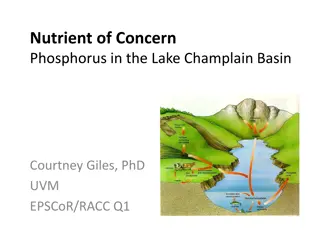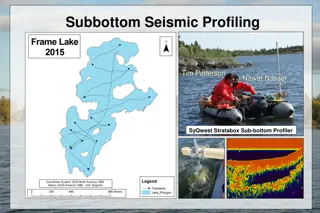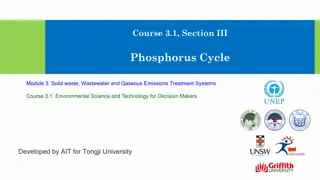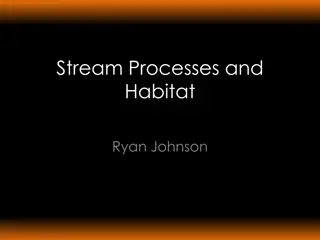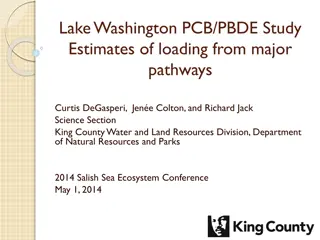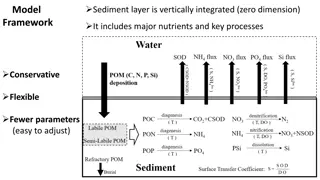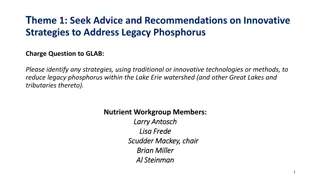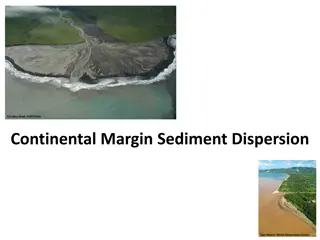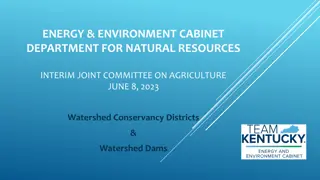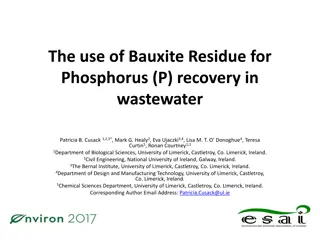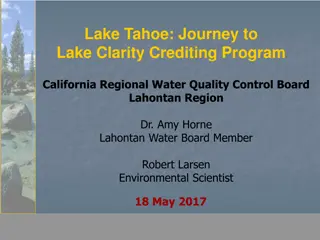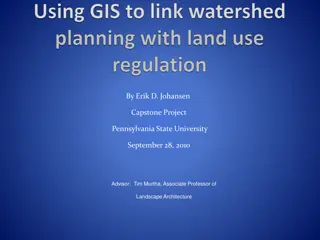Estimation Methodology for Phosphorus and Sediment Loading in Cayuga Lake Watershed
"Explore the process of estimating phosphorus and sediment loading at the south end of Cayuga Lake using LOADEST methodology. Learn how to combine synoptic monitoring data with USGS flow measurements and run calculations to obtain yearly load numbers. Get step-by-step instructions and access helpful resources for conducting this analysis."
Download Presentation

Please find below an Image/Link to download the presentation.
The content on the website is provided AS IS for your information and personal use only. It may not be sold, licensed, or shared on other websites without obtaining consent from the author.If you encounter any issues during the download, it is possible that the publisher has removed the file from their server.
You are allowed to download the files provided on this website for personal or commercial use, subject to the condition that they are used lawfully. All files are the property of their respective owners.
The content on the website is provided AS IS for your information and personal use only. It may not be sold, licensed, or shared on other websites without obtaining consent from the author.
E N D
Presentation Transcript
Loading of Phosphorus and Sediment to the South End of Cayuga Lake LOADEST Estimates Based on CSI- Volunteer Synoptic Sampling Partnerships, 2002-2013 Tompkins County Water Resources Council April 21, 2014
Cayuga Lake Watershed: CSI Monitoring Sites
Synoptic Sampling of Streams, From Mouth to Headwaters Volunteer groups monitor tributary streams in southern Cayuga Lake watershed Monitor means that groups perform synoptic sampling several times per year at fixed locations along a stream s entire length CSI s lab performs certified analyses of synoptic samples for phosphorus, sediment and other water quality parameters Results are posted on CSI s website and may be searched and downloaded free of charg
Combine Synoptic Monitoring Results with USGS Flow Measurements Load = Concentration x Flow = mg/L x L/sec Transform units to get load in tons/year Concentrations come from synoptic monitoring Flows come from USGS gauging stations Flows estimated in absence of gauging station LOADEST Calculations by Dr. Matthew Yarrow
Simple step-by-step description of LOADEST Load Estimation Methodology Description Download Phosphorus concentration data from CSI Website Download daily average and instantaneous flow data from USGS website Download Latest LOADEST version (2013) and documentation Calculate watershed area at CSI monitoring location - StreamStats Estimate flows at CSI monitoring site using watershed are ratio method Create Calib file for each analyte (SRP and TP) including instantaneaous flow estimations and CSI concentration data Create Est file using daily average flow data Run LOADEST for Model 1 and using model auto-select option Select model with best model fit stats for a given analyte and watershed Obtain load results from LOADEST for each parameter for selected model Sum loads over water years to get final yearly load numbers Optional step: determine days with significant stormwater flow in order to estimate loads occurning during stormwater events versus days with base flow. Step More Info Website 1 2 3 Website Website 4 Website 5 6 7 8 TP_Calib!A1 9 Model Fit'!A1 10 11 Load_Results!A1 Yearly Totals'!A1 Online baseflow separation tool 12 LOADEST Documentation Runkel, R.L., Crawford, C.G., and Cohn, T.A., 2004, Load Estimator (LOADEST): A FORTRAN Program for Estimating Constituent Loads in Streams and Rivers: U.S. Geological Survey Techniques and Methods Book 4, Chapter A5, 69 p.
Sediment Loading To Fall-Virgil Creek TSS Loads (tons/yr) 2009 2010 2011 2012 2013 Davis Road Bridge 558 500 1502 409 733 Virgil Creek Freeville 1736 1686 6090 1083 2598 Fall Creek Freeville 1340 1220 3816 954 1807 Freese Road Bridge 7834 8435 35432 4118 13774 Cayuga Street Bridge 10946 10882 40862 6562 16996
Total Phosphorus Loading to Fall-Virgil Creek TP Loads (tons/yr) 2010 2011 2012 2009 2013 Davis Road Bridge 2.86 2.49 6.10 2.37 3.48 Virgil Creek Freeville 2.95 2.59 7.02 2.32 3.72 Fall Creek Freeville 4.03 3.52 8.89 3.30 4.96 Freese Road Bridge 12.28 10.80 29.22 9.66 15.46 Cayuga Street Bridge 15.06 13.40 38.49 11.41 19.45
Soluble Reactive Phosphorus Loading to Fall-Virgil Creek SRP Loads (tons/yr) 2009 2010 2011 2012 2013 Davis Road Bridge 1.46 1.27 2.95 1.24 1.75 Virgil Creek Freeville 0.92 0.80 1.87 0.78 1.11 Fall Creek Freeville 1.78 1.55 3.62 1.51 2.14 Freese Road Bridge 3.53 3.07 6.65 3.09 4.18 Cayuga Street Bridge 3.24 2.82 6.34 2.80 3.87
Sediment (TSS) Loading from Major Tributaries to Cayuga Lake (tons/year) 2011 2012 2013 Average Fall Creek Mouth Six Mile Creek Mouth Cayuga Inlet Mouth CI Farmers Market Cascadilla Creek Mouth 40,862 6,562 16,996 21,473 30,241 3,202 4,343 12,595 43,388 8,366 8,475 20,076 51,933 7,642 8,191 22,589 2,240 633 615 1,163
Total Phosphorus Loading from Major Tributaries to Cayuga Lake (tons/year) 2011 2012 2013 Average Fall Creek Mouth 38.49 11.41 19.45 23.11 Six Mile Creek Mouth 17.56 4.57 4.55 8.89 Cayuga Inlet Mouth 45.26 13.42 12.61 23.76 CI Farmers Market 45.80 11.91 11.40 23.04 Cascadilla Creek Mouth 3.88 1.74 1.56 2.39
Soluble Reactive Phosphorus Loading from Major Tributaries to Cayuga Lake (tons/year) 2011 2012 2013 Average Fall Creek Mouth Six Mile Creek Mouth Cayuga Inlet Mouth CI Farmers Market Cascadilla Creek Mouth 6.34 2.80 3.87 4.34 2.12 0.99 0.89 1.33 5.18 2.21 2.02 3.14 4.84 2.10 1.92 2.95 1.26 0.60 0.54 0.80
Comparisons of Average Loads for Sediment (TSS), Total Phosphorus and Soluble Reactive Phosphorus 2011-2013 Average TSS Load (tons/yr.) 21,473 2011-2013 Average TP Load (tons/yr.) 23.11 2011-2013 Average SRP Load (tons/yr.) 4.34 TP/TSS x 1,000 SRP/ TP Fall Creek Mouth Six Mile Creek Mouth Cayuga Inlet Mouth CI Farmers Market Cascadilla Creek Mouth 1.07 0.19 12,595 8.89 1.33 0.71 0.15 20,076 23.76 3.14 1.18 0.13 22,589 23.04 2.95 1.02 0.13 1,163 2.39 0.80 2.06 0.33




